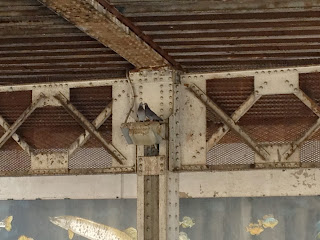The two owl decoys on the southside of Pratt Avenue viaduct haven't done much to scare off the pigeons at the Pratt Avenue "L" viaduct. Pigeon guano has accumulated in large piles on both sides of the street. The stop sign on Glenwood which hangs from the viaduct is covered in it.
According to some pigeon guano is great fertilizer. One account (regarding watermelons) in particular was a bit too fantastic but hilarious by one poster named foolishpleasure. Vegetablegarderner.com calls bird guano "premium stuff" and goes on to relate that people in Europe and the Middle East kept dovecotes to house the birds just for this purpose. Currently the uncovered beams of the Pratt "L" viaduct are home to at least five to six pigeons. One poster named Santadercol claims to have 130 birds that produce literally a ton of guano a year. In the post the process of composting pigeon poop is outlined in detail.
Last edited 12/29/13 11:10 am
Please continue reading for more pictures and words
Owl decoys work best when they have moving parts and when things are changed up a bit. Installing a plastic owl does work for a little while. But the pigeons eventually catch on that they never move and they soon ignore them. The south end of the viaduct has two owl decoys. One on either side of the support beams. In this New York Times article the results were mixed, "you can fools some of the pigeons some of the time but not all of the pigeons all of the time". If the CTA and city wanted to to drive the pigeons out they would install bird deterrent spikes and a pigeon net (seen here at the Jarvis viaduct) or iron grating on the the uncovered beams.
The Urban Wildlife Society compiled a list of quotes from respected officials regarding the actual dangers of catching pigeon borne illnesses. Those at highest risk are those who breed and keep pigeons as pets. This JAMA abstract looks at three people who caught an acute interstitial pneumonitis (allergic reaction to the droppings but not an actual infection). This article from the Journal of Infection discusses "Health Hazards Posed By Feral Pigeon". Only 176 cases described from 1941 to 2003. Almost one hundred percent of the cases were transmitted from inhalation and the most common infections psittacosis and cryptococcus.
Pigeons and their poop don't pose a huge public health issue except to those with compromised immune systems or hobbyists. However if anyone were to harvest these droppings they should definitely wear gloves and a mask. The biggest risk to anyone is inhaling dust kicked up from the droppings. And if there was any place in Rogers Park where anyone would be at high risk at catching one of these uncommon diseases this would be it.






















No comments:
Post a Comment